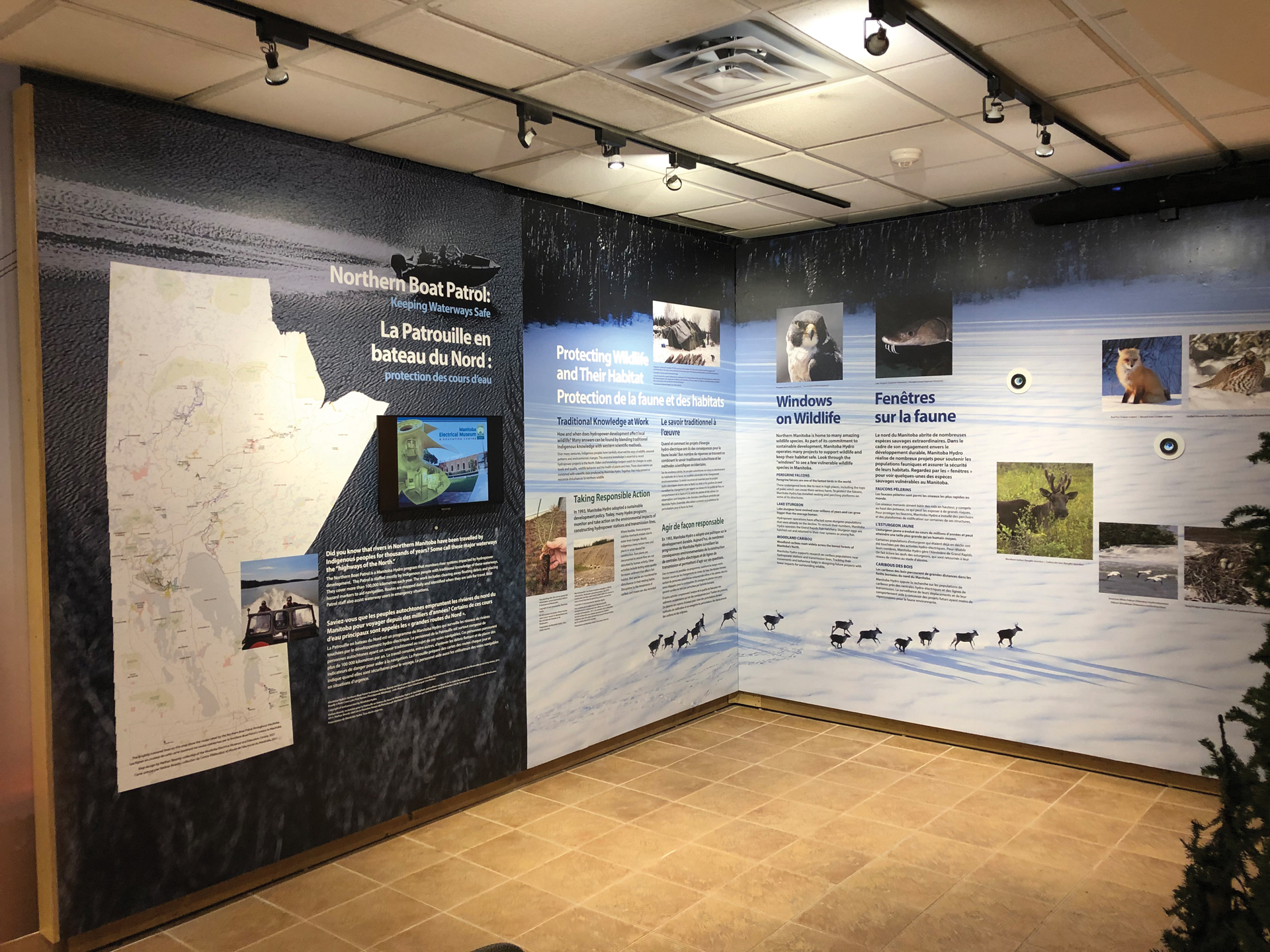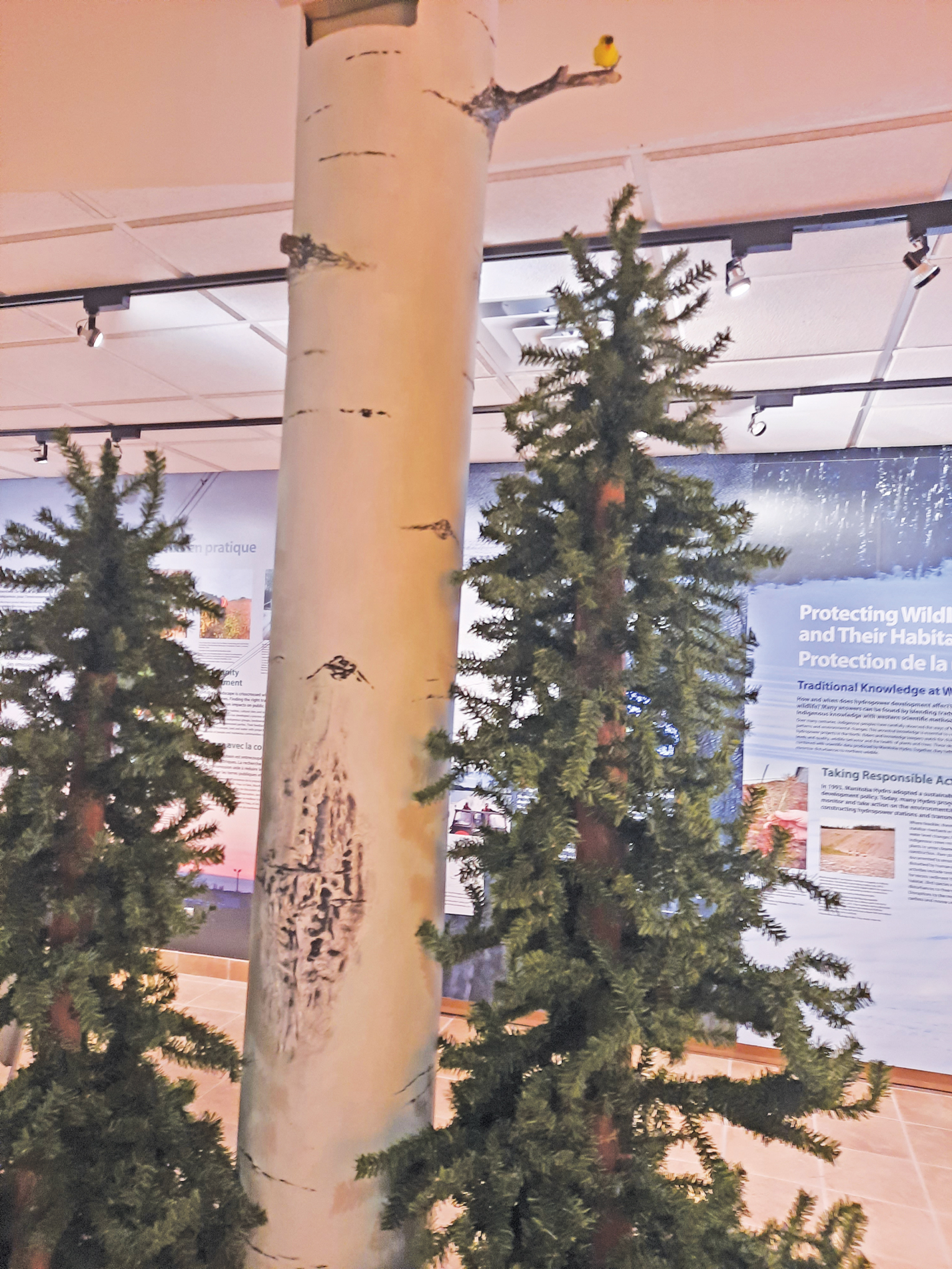
Introductory text. The back-lit panel is by Darryl Hartle, 23 Below Design. Photo — Manitoba Electrical Museum & Education Centre.
Sustainable Development: Caring for our Common Future
Pamela McKenzie
The Manitoba Electrical Museum & Education Centre is located in Winnipeg, Manitoba and housed in a working Manitoba Hydro substation. In its 20th year of operation, the museum has undertaken the refurbishment of the existing main-floor gallery and the total redevelopment of the lower level. Amid discussions dating back to 2019 on how the museum could remain relevant to the community both locally and nationally, and a world dealing with climate change, environmental challenges, and Truth and Reconciliation, it was decided to focus on the overarching topic of Sustainable Development. The intent of the exhibits is to illustrate how hydropower as a renewable energy source contributes to the goals of sustainable development in Manitoba, and Canada more broadly.

A medicine basket. Photo — Manitoba Electrical Museum & Education Centre
Sustainable Development as a concept was introduced in a 1987 report by a special United Nations World Commission on Environment and Development entitled Our Common Future. Since then, Sustainable Development has come to mean many different things to many people. Most commonly, it is understood to mean protecting the environment. While environmental protection is an integral component, sustainable development is a much larger idea which encompasses a broader range of values including gender equality, human rights, promotion of peace, security and non-violent conflict resolution, as well as actively promoting cultural diversity and the rights of Indigenous peoples.
In this new exhibit, we focused on a sustainable energy source, hydropower, and its relation to the environment and Manitoba’s Indigenous peoples.

Indigenous Learning Circle. Photo — Manitoba Electrical Museum & Education Centre
Indigenous Partners in Sustainable Development
In the past, hydro development has come at significant cost to northern Indigenous communities. Flooding damaged traditional hunting and fishing grounds, disrupted culturally sensitive sites and in some instances, displaced entire communities. This was not sustainable. An action plan was needed to address existing issues and barriers with a goal of developing and maintaining long-term harmonious relationships.
In 2004, the Nisichawayasihk Cree Nation became a part-ner in sustainable development with Manitoba Hydro in the building of Wuskatim, a 200-megawatt generating station on the Burntwood River in northern Manitoba. (‘Wuskatim’ is a Cree word meaning ‘beaver dam.’) They used traditional knowledge to reduce the amount of land flooded to less than half a square kilometer. This partnership produced long-term community benefits, job skills and career development.
In 2009, four Indigenous communities partnered with Manitoba Hydro to build Keeyask, an enormous 695-megawatt generating station on the Nelson River, within the ancestral homeland of all four partner First nations. (‘Keeyask’ is a Cree word meaning ‘gull’). These communities, Tataskweyak Cree Nation, War Lake First Nation, York Factory First Nation and Fox Lake First Nation, negotiated employment and business opportunities to help build their economies and support the future of their young people.

Museum volunteers testing the virtual binoculars. Photo — Manitoba Electrical Museum & Education Centre
The Museum felt these were important stories worth telling in greater detail. An exhibits committee was formed in late 2019, comprised of a researcher, a writer, a retired hydro executive, museum staff and three Indigenous community members. These were new connections forged for this exhibit and the expertise and contribution of the Indigenous members was incorporated into every part. A highlight of the exhibit is an interview series featuring an Indigenous Elder and an Indigenous Knowledge Keeper speaking of the Aboriginal Traditional Knowledge connecting earth, water and all life on earth. The museum hired a young aboriginal filmmaker who, with her award-winning fledgling company, who brought a distinctive cohesive voice to our video presentations. Our Learning Circle, complete with log benches and a display of traditional medicines, is the perfect setting for these important teachings.

Tele-post trees. Photo — Manitoba Electrical Museum & Education Centre
The second significant area addressed the impact of hydropower on the environment and wildlife. Manitoba Hydro follows very extensive environment plans that address sediment management, fisheries offsetting & migration, vegetation rehabilitation, terrestrial migration implementation, access management and heritage resource protection. Indigenous partners monitor northern waterways and work to revitalize the natural habitat of trees, grasses and wildlife. Our specially designed Windows on Wildlife exhibit afforded visitors the opportunity to study lake sturgeon, woodland caribou and peregrine falcons, in their natural surroundings. Indigenous traditional knowledge of natural habitat, waterways, fish, bird and wildlife behavior, and rare ecosystems are vital to sustainable development goals to balance the needs of humanity and nature.
Youth and Education
The whole exhibit, while speaking to a serious topic such as sustainable development, delivers a vibrant, youth-focused experience. While we’ve only just reopened, on-site staff can see that the interactive elements of the Learning Circle and Windows on Wildlife are a hit in engaging young people, while imparting important messages of conservation and environmental awareness.
The exhibit was designed to engage those of all ages. Windows on Wildlife is comprised of virtual binoculars inset in the illustrated text panel at three different heights: 42”, 55” and 68”, accommodating guests of varying heights and abilities to view the wildlife videos. Conceived by exhibit writer Paula Kelly, this hands-free alternative to hard, hand-held binoculars was also COVID friendly. While it can sometimes be hard for small museums to find a budget to work with professional exhibition developers, we’ve found that it is an expense worth taking on to ensure that our offerings are thought-provoking, entertaining and very professional-looking.
The exhibit also complements new school programs beginning in September. The schools will teach key themes of sustainable development: poverty alleviation, human rights, health, environment protection and climate change. With this exhibit, the Museum is now equipped to offer a hands-on, interactive exhibit, to augment and illustrate these key concepts and support classroom learning.
On an individual level, the museum asks, “What would you do to keep the planet safe?” This question instills the belief that their personal actions can make a difference. Walking to school or work, planting a tree or garden, re-cycling drink containers, conserving water or simply turning out the lights when they leave a room, all can make a difference and ultimately help create a better world for all. We know that the voices and actions of youth are essential to achieving sustainable development, as they will be most impacted in the future by decisions made today.
So, this is the goal: to teach the core values of sustainable development, to care for the planet and keep the earth clean, green and safe for future generations. To be responsible, respectful and renewable. We are proud and happy to contribute to this dialogue. M

Photo — Manitoba Electrical Museum & Education Centre
Pam McKenzie is the Administrator of the Manitoba Electrical Museum & Education Centre. Previously head of Library & Archives at the Royal Aviation Museum of Western Canada for many years, Pam has written two books, “The Lewis Letters”, a historical biography, and “Violet in Silence”, illustrated children’s poetry. Pam has mentored many young museum professionals over the years, and feels exceedingly confident in the future of museums in this country.
